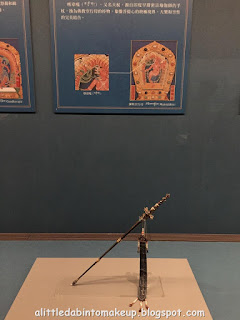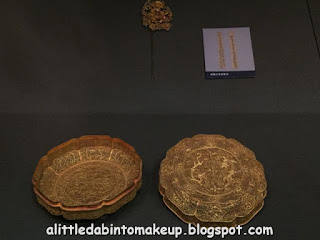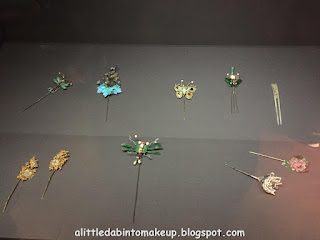Still more photos from the National Palace Museum (故宮)! We're almost through, folks. Almost.
These are of metal-crafts in a religious context, in this case, Buddhism.
These are of metal-crafts in a religious context, in this case, Buddhism.
Top row: Mahakala ("beyond time/death," Daheitian or Daikokuten, 大黑天), the ultimate form of Shiva and consort of Kali.
Bottom row: Virudhaka Lokapala, ("he who causes to grow," Zeng Zhang Tianwang or Zocho-ten, 增長天王), one of the Four Heavenly Kings, namely the Heavenly King of the South.

Unfortunately, I don't know the name of the bronze pagoda below. You'd think I'd taken enough photos of this entire museum, but somehow I'm still missing info =.=
Either way, the pagoda makes me think of the weaponized golden pagoda belonging to Li Jing (李靖, not to be confused with Li Jing, 李靖, a prominent general from the early Tang), a deity in Chinese folk religion and mythology known as the "Pagoda-Bearer Heavenly King Li" (Tuota Li Tianwang, 托塔李天王). A comparable Buddist deity to Li Jing would be Vaisravana Lokapala ("he who hears all," Duowen Tianwang/Pishamen Tian or Tamon-ten/Bishamon-ten, 多聞天王/毘沙門天), the chief of the Four Heavenly Kings, namely the Heavenly King of the North.
As the story goes, the "Burning Lamp Taoist" (Randeng Daoren, 燃灯道人) granted the pagoda to the then-mortal Li Jing, with which he used to subdue his youngest, an ill-tempered, violent, and rebellious child-god by the name of Nezha (哪吒). What, a mortal dad against a child-god with supernatural abilities? Sounds hardly fair, right? After Nezha defeated his Buddhist-trained middle brother Muzha (木吒) and was about to force Li Jing to commit suicide, the deities had to step in. What a brat!
How does the pagoda work? Well, when not in use, it was a miniature Li Jing cradled in his right arm. To put to good use, Li Jing recited a scripture that returned the pagoda to a life-size tower, whereupon it became engulfed in flames and could imprison any god(s) or demon(s) until another verse of scripture released its captive(s). So whenever Nezha raised hell, his poor dad would ground him inside the burning pagoda. When he calmed down again, dad would then let him out to play. The joys of parenting!
More bronze Buddha statues.
Framed sutra sections (more below).
Paintings of some of the Eighteen Arhats.
Someone took the pain to recreate the weapons and tools belonging to various Buddhist deities!
Top: The Four Heavenly Kings with the God of Wealth at the center. From left to right, Virudhaka Lokapala (see above at beginning of post), Dhrtarastra Lokapala ("he who upholds the realm," Chi Guo Tianwang or Jikoku-ten, 持國天王) the Heavenly King of the East, Yellow God of Wealth (黃財神, not sure why "yellow," perhaps because gold is a symbol of wealth?), Vaisravana Lokapala (see above at Li Jing and the story of the golden pagoda), and Virupaksa Lokapala ("he who sees all," Guang Mu Tianwang or Gomoku-ten, 廣目天王) the Heavenly King of the West.
More framed sutra sections.
Decorations and jewelries made from metals and precious stones.
Archer's rings from jade, porcelain, and bone.

Jewelries and fasteners for the emperor's hats.
Jade pendants.
Jewelries.

Right photo: the claw-like pieces aren't for the hair but for the fingertips. These were the imperial Qing dynasty's equivalence of fake nails, and court women wear one on the tip of the pinkies, or two on their pinky and their ring finger.




























































































No comments:
Post a Comment